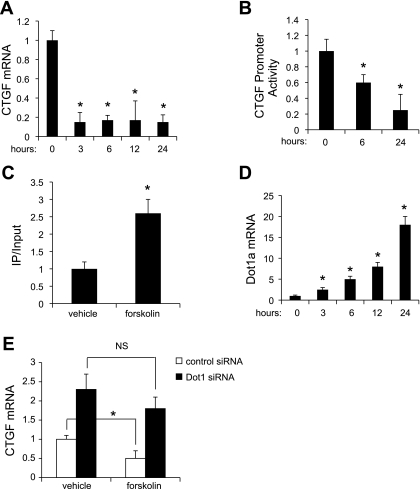Fig. 2.
Forskolin inhibits CTGF mRNA expression and promoter activity as it increases H3K79me3 methylation associated with chromatin at the CTGF 5′-flanking region and Dot1 mRNA expression. A: mesangial cells were treated with vehicle or forskolin (1 μM) for the indicated number of hours, and total RNA was harvested for analysis of CTGF and β-actin mRNAs from the same sample levels by quantitative RT-PCR. The CTGF mRNA value was normalized to that of β-actin, which was invariant under the 2 conditions. *P < 0.05 vs. vehicle-treated cells, n = 4. B: luciferase assay demonstrating that forskolin inhibits the activity of the stably incorporated CTGF promoter-luciferase construct in a time-dependent manner. *P < 0.05 vs. vehicle-treated cells, n = 3. C: ChIP-qPCR analysis of H3K79me3 occupancy at the CTGF 5′-flanking region. Mesangial cells were treated with vehicle or forskolin (1 μM) for 24 h. ChIP assays were then performed with antibody directed against H3K79me3 or nonimmune IgG followed by qPCR with a primer set designed to amplify −3491 to −3070 of the CTGF gene. The value for the final amplicon/input DNA with anti-H3K79me3 from the vehicle-treated cells was set as 1, and the value from the forskolin-treated cells was normalized to it. Values are means ± SE of 3 separate experiments, each performed in triplicate. D: Dot1 mRNA levels were measured in mesangial cells treated with forskolin (1 μM) for the indicated number of hours by quantitative RT-PCR. The levels were normalized to that of β-actin, which was invariant under the 2 conditions. *P < 0.05 vs. vehicle-treated cells, n = 4. E: Dot1 knockdown abrogates the ability of forskolin to inhibit CTGF mRNA expression. Mesangial cells were transfected with scrambled control siRNA or Dot1-specific siRNA. The transfected cells were treated with vehicle or forskolin (1 μM) for 24 h, RNA was then harvested, and quantitative RT-PCR was used to determine CTGF mRNA levels. *P < 0.05 vs. vehicle-treated cells, n = 5. NS, not significant.

